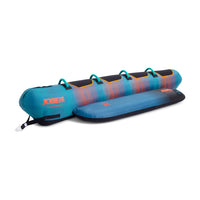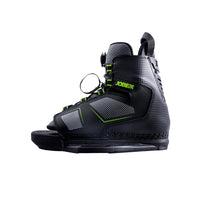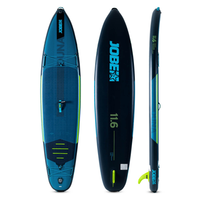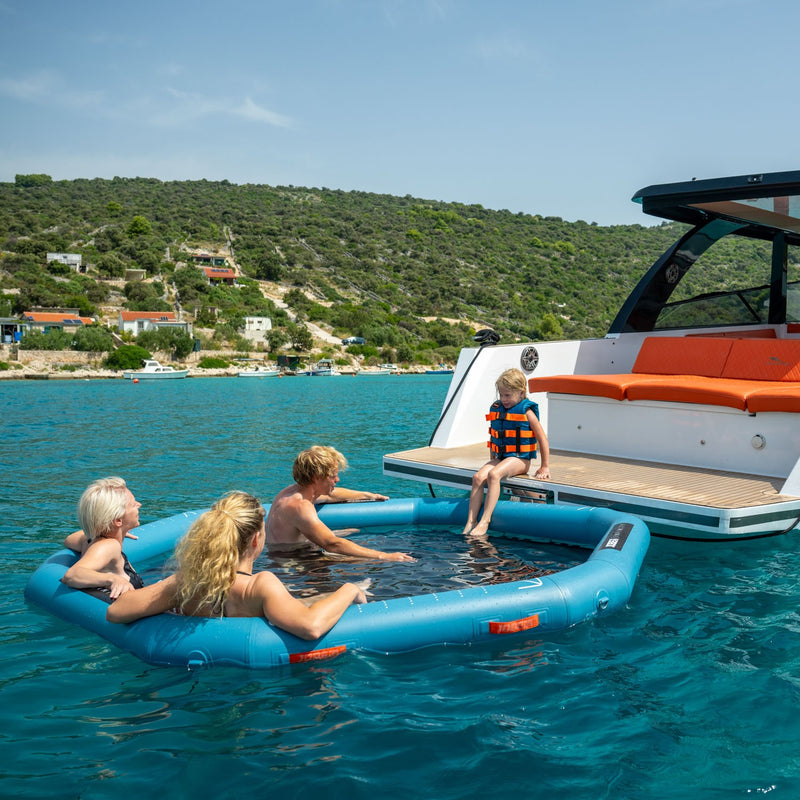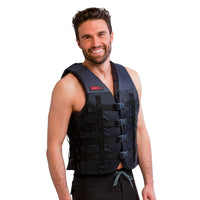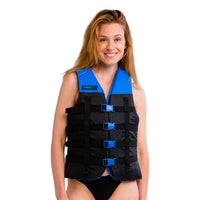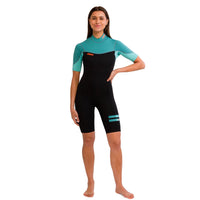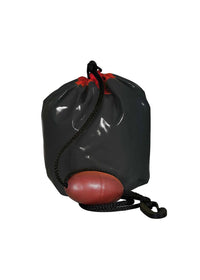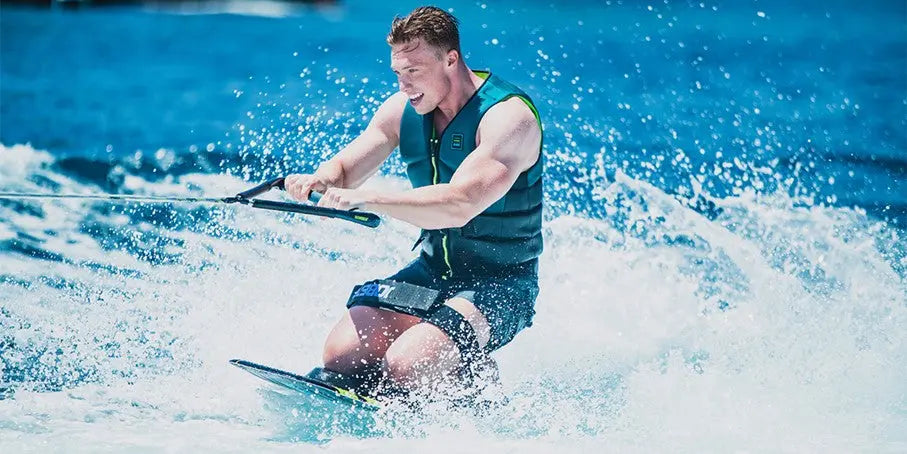
Ultimate Kneeboarding Guide (2024)
Kneeboarding: The Ultimate Guide (2024)
Kneeboarding is a water sport that involves riding a small, flat board on your knees while being towed behind a boat. Unlike a wake- or surfboard, a kneeboard is smaller and has a pad for your knees.
Kneeboarding is a popular water activity for people of all ages and skill levels. It can be performed in a variety of water conditions, from lakes to rivers.
How does a kneeboard work?
A kneeboard is designed to be worn on the user's knees while they are being towed behind a boat. The kneeboard consists of a flat, padded surface that the user kneels on, and it typically has one or two fins on the bottom to help with stability and manoeuvrability.To use a kneeboard, the user kneels on the padded surface with their feet hanging off the sides and their hands gripping the handle at the front of the board. The kneeboarder is then towed from a boat or watercraft.
While riding a kneeboard, the user can perform a variety of tricks and stunts, such as jumps, spins, and flips. They can also use the fins on the bottom of the board to carve turns and make other manoeuvres.
How to start with a kneeboard?
If you're new to kneeboarding and want to get started, here are some general steps to follow:- Get the right equipment: In addition to a kneeboard, you'll need a tow rope, a life jacket, and a properly equipped watercraft such as a boat or jet ski.
- Find a safe location: Choose a location that is free of obstacles and has enough room for the watercraft to safely operate. Avoid areas with swimmers or other boats.
- Get proper training and supervision: If you're new to kneeboarding, it's important to get proper training and supervision from a qualified instructor. This will help you learn the proper techniques and safety guidelines to follow while kneeboarding.
- Practice getting up on the kneeboard: Practice getting up on the kneeboard in shallow water or on land. This will help you build confidence, find your balance and get a feel for the board.
- If the kneeboard has an easy start tow hook, put the towrope in there, if not simply hold the rope. To start first lay on the kneeboard on your belly and firmly hold the board or the rope. Let the boat driver slowly tow you forward, then slowly get up on your knees and secure the knee strap.
- Start slow: When you're ready to start kneeboarding behind a watercraft, start slow and build up your speed gradually. This will give you a chance to get used to the feel of the board and the motion of the water.
- Have fun: Kneeboarding is all about having fun and enjoying the thrill of gliding through the water. Don't be afraid to try new tricks and stunts, and always make safety your top priority.
.jpg)
Which tricks can I do on a kneeboard?
There are many different tricks that can be performed on a kneeboard, ranging from basic manoeuvres to advanced stunts. Some common kneeboard tricks include:- 360: A 360 involves spinning the board around in a complete circle while riding on it.
- Backroll: A backroll involves riding up the wake, then flipping the board and body backward, landing back on the board in a riding position.
- Frontside flip: A frontside flip involves riding up the wake, then flipping the board and body forward, landing back on the board in a riding position.
- Ollie: An ollie is a basic trick that involves popping the board off the water and into the air by pressing down on the tail of the board and pulling up on the front
- Surfing: Kneeboard surfing involves riding the waves and performing tricks on the board.
- Tail grab: A tail grab involves grabbing the tail of the board with one hand while riding.
- Wake jump: A wake jump involves riding up the wake and jumping off the board into the air.
- Wipeout: A wipeout is when the rider falls off the board, either intentionally or unintentionally.
What kind of boat do I need for kneeboarding?
1. Preparing the boat:- Generally, any boat capable of towing water sports can be used for kneeboarding. Inboard, sterndrive, or outboard boats can all work well.
- Ensure the boat has enough power to pull the rider comfortably and maintain a consistent speed.
- With an inboard engine, you can attach the tow rope pretty much anywhere on the back-half of the boat. With an outboard engine, you need to keep in mind that the rope, board and rider always need to steer clear from the engine, more specifically, the propellor. In order to stay safe, riders can attach a bridle to the back left and back right of the boat, leading to a point in the middle where to towing rope can be attached. As for engine size, as long as the boat has enough power to keep the rider standing, you’re good to go.
- The optimal speed for kneeboarding varies depending on the rider's skill level, weight, and preference. As a starting point, try a speed of around 15 to 20 miles per hour (24 to 32 kilometers per hour) and adjust based on the rider's comfort and control.
- Experiment with different speeds to find the sweet spot that allows the rider to maintain balance and perform tricks while enjoying the ride.
- Always wear a properly fitted, ISO-certified life vest when kneeboarding. Safety should be the top priority.
- Ensure the boat's driver and spotter are experienced and knowledgeable about towing water sports and understand hand signals for communication with the rider.
- Establish hand signals for communication between the rider and the boat's occupants. Clear communication is crucial to ensure everyone's safety. For example, once the boarder has fallen, a simple thumbs up can show the people on the boat that the boarder is fine and not in need of an emergency pick-up.
- Before towing a rider, make sure the area is clear of any obstacles, such as rocks, buoys, or other boats. Maintain a safe distance from shorelines, docks, and swimming areas.
- Be mindful of other boaters, swimmers, and water sports enthusiasts.
- Observe local boating regulations and laws. Understand the right of way, no-wake zones, and speed limits enforced in your area.
- Respect the environment by properly disposing of trash and avoiding the release of pollutants or contaminants into the water.
.jpg)
Which kneeboard is best for me?
The best kneeboard for you will depend on your personal preferences and needs. Here are a few factors to consider when choosing a kneeboard:
- Size and weight capacity: Make sure the kneeboard you choose is the right size and weight capacity for you. Kneeboards are generally designed for riders of different sizes, so it's important to choose one that is appropriate for your weight and height.
- Skill level: Consider your skill level and the type of activities you plan to do on the kneeboard. Some kneeboards are designed for beginner riders, while others are better suited for more advanced riders who want to perform tricks and stunts.
- Construction: Look for a kneeboard that is made of durable materials and has a solid construction. The board should have a padded surface for comfort and a sturdy handle at the front for grip.
- Fins: Kneeboards typically have one or two channels on the bottom to help with stability and manoeuvrability. Consider the size and shape of the fins and how they will affect the performance of the board.
- Price: Kneeboards can range in price from a few hundred dollars to over a thousand dollars. Decide on a budget and look for a kneeboard that offers the features and performance you need within that price range.

Ultimately, the best kneeboard for you will be the one that meets your needs and allows you to have fun on the water.
Jobe Prophecy
The Jobe Prophecy Kneeboard is another step up from its predecessor. The Prophecy is a great board for both intermediate and advanced boarders. The high-pressure core, fully padded knee strap and knee pad are just part of what makes this board so great! The Prophecy also features contoured fins and deep channels for extra traction to take your kneeboard game to the next level!




